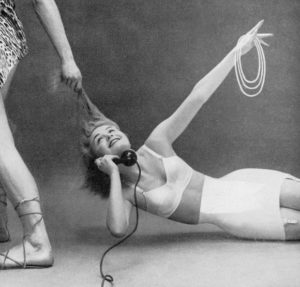
Artist Hank Willis Thomas is hoping to change that with his latest exhibition, “Unbranded: A Century of White Women, 1915-2015,” showing at the Jack Shainman Gallery in New York until May 23.
The exhibit strips advertisements from the last century of their text and branding in order to draw attention to the raw images that are ubiquitously displayed throughout pop culture.
Without the distracting logos and catchy slogans covering the advertisements, all that’s left are racist, sexist images that glorify the image of white women when compared to their Black counterparts while also ensuring women aren’t portrayed in a way that makes them equal to men.
The majority of the advertisements supported three troubling ideas: Black women are subservient to white women, women will always be competitors rather than companions, and even as women make strides towards equality they will still continue to be measured by their sexuality and physical attributes.
“A lot of the ads in the exhibition show women with their husbands, or their daughters, or their lovers,” The Guardian writes of the New York exhibit. “But there isn’t a single ad that shows female friends together, enjoying each other’s company while fully clothed.”
When women did appear to be happy in a group together, they were flaunting bikinis or other scantily clad displays that seemed to be ripped from a man’s fantasy.
Then there were the collection of ads that served as a troubling reminder for women to not feel too comfortable about the strides they have made in garnering equality in the workplace and society as a whole.
As women were finally getting the right to vote and were taking up roles in the military and holding down full careers, the ad world exploded with messages that objectified them.
“This is particularly evidenced in the 1960s where many of the ads show women decapitated, bruised, caged, or being pulled apart by men,” The Guardian explains. “You can count your freedoms, the images seem to say, but the sum of a woman still boils down to aging skin and sexual orifices.”
One of the cringe-worthy photos has a petite woman in her underwear as she is surrounded by a group of men in business clothes tugging away at her arms.
Eerie smiles have crept across their lips as the woman’s hair swings down in front of her face.
In the sea of misogynist ads breaking women down to little more than the objects of fantasy and cattiness, racism also makes its presence known.
The ads have a stunning lack of Black women present overall, but when they do make an appearance their purpose is clear.
They are typically serving a white woman or meant to represent something exotic and “other.” They are never merely a part of the community at large.

Fortunately, more modern ads did finally incorporate more positive representations of Black women with the help of well-known figures like Serena Williams
In one ad she is seen accepting a gift from a white woman kneeling in front of her for a Tampax advertisement.
Thomas noted that “the rise in appreciation” for these Black women can be credited not only women like Serena but also Michelle Obama and Beyonce.
As such figures rose to popularity, it forced ads to take a different look at the underlying messages they tried to send in their ads.
The exhibit marks yet another time that Thomas has explored the messages in advertisements.
In 2007 he highlighted the presence of Black men in ads with “Unbranded: Reflections in Black by Corporate America, 1968-2000.”


